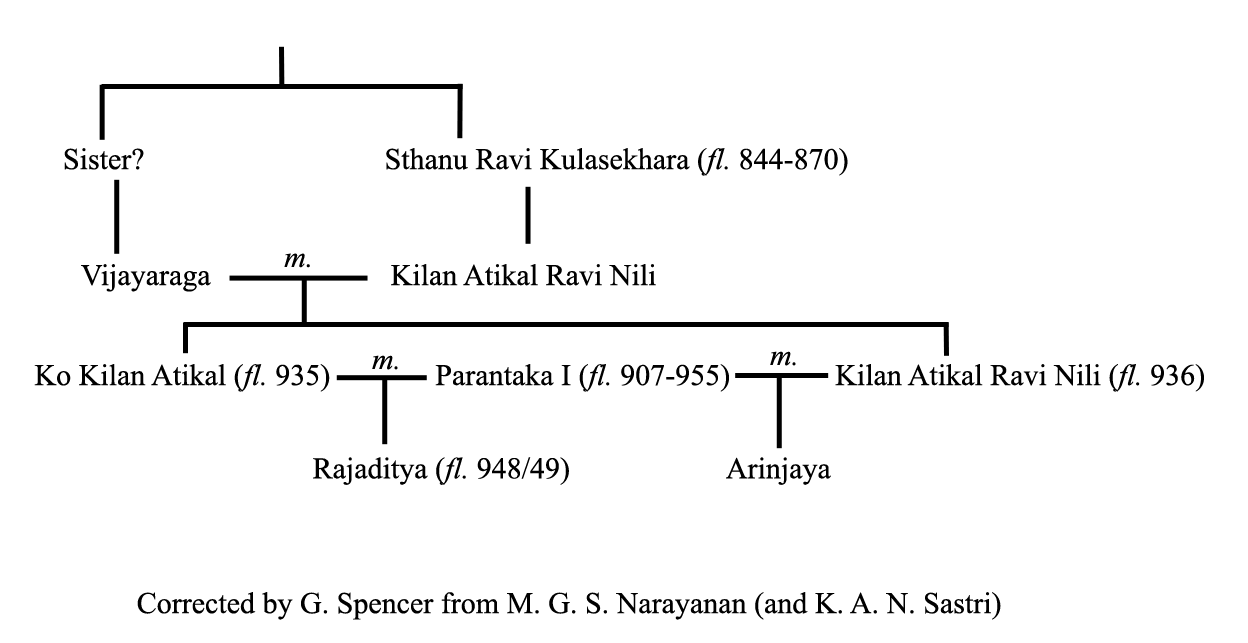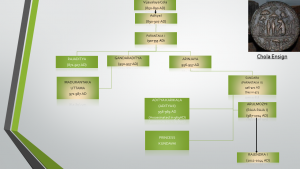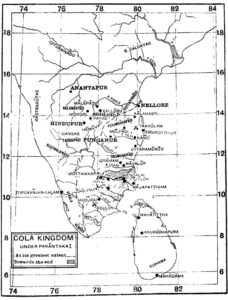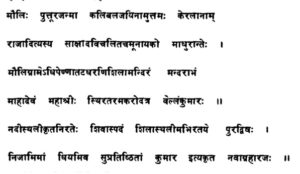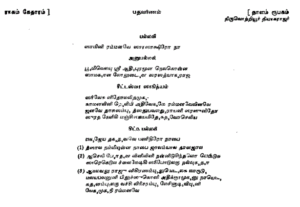Prologue:
Our country in the past has sired a great number of men whose valour, glory, contribution and many a times their very existence has been long forgotten, unwept and unsung. One such personality is Caturanana Pandita who is the subject matter of this blog post. He was a monk or the head of a monastic institution and more precisely a ‘mahAvratin’ – (observer of a great vow) a member of a holy order of monks belonging to the kALAmukha sect of Saivas. Historical records reveal that there was a succession of Caturanana Panditas between 950 CE-1175 CE, all of them being the head of the monastery at Tiruvottriyur (near Chennai) . The subject matter of this post is Caturanana Pandita I who in fact set up the monastery at Tiruvottriyur and became its first titular head or Pontiff circa 957 CE. His history is an enigma and only through the works of a handful of epigraphists & historians, are we able to connect the dots and get to know this personality. This blog has been structured to look at the life sketch this Caturanana Pandita, the details as to the kALAmukha tradition of Saivas (which is virtually extinct today) to which he belonged to and we would end it of course with a homage by way of a composition.
An inscription attesting to this great personality was made 1077 years ago or to be exact, 14th of January 943 CE, in a temple in remote Tamilnadu.
kALAmukhas – A brief primer on an old Saivite tradition:
Sadly, as of today, no religious material or text in full pertaining to the practice of Kalamukhas have survived to reach us to provide us with first hand evidence as to their beliefs & practices. Lakulisa is the 28th avatara of Siva as mentioned in the Lingapurana. It is said that Lakulisa had four shishyas – Kusika, Garga, Maitreya and Kaurushya. From each of these four shishyas originated , Pasupata, Kapalika, Kalamukha and Saiva. According to the Vamana Purana, it is said that Kalamukhas were founded by Apastamba and his shishya Kratheshvara. The Kalamukhas based on inscriptional evidence seem to be orthodox brahmanas studying Veda and Sastra and thus different from Kapalikas.
The Kalamukhas were often clubbed together with the Kapalikas in terms of a negative portrayal by Ramanujacharya and Yamunacharya. Similar to the Kapalikas, some of the characters found in literary works such as “mAlatimAdhavA”, has cast even the kALAmukAs too in bad light. Notwithstanding the same it can be said the Kalamukhas were primarily reclusive students of Vedas and sastras – nyayavaisheshika in particular and were worshippers of Lord Shiva, who undertook ascetic vows thereby getting the designation of mahavratins. They had their own matAs or monasteries and also enjoyed the patronage of the wealthy and the Royals. Their name derives from their practive of smearing their foreheads (sometimes the face) with a dark bhasma.
What commands our attention next is the form of Lord Shiva that these Saivas propitiated. While the fearsome Lord Bhairava was the presiding deity of the kApAlikAs, the Kalamukhas worshipped Lord Lakulisa. Lakulisa is represented as a naked yogi, carrying a japamala, a laguda or a club and a kapala or human skull. Befitting his yogic stance, he is also represented as urdhva-retah (ithyphallic). However there is an interesting form of Lakulisa , interpreted by some to be a form of Lord Dakshinamurti called as Gaulisa. In this context I invite the attention of the discerning reader to the existence of a shrine in Tiruvottriyur , near Chennai in the temple complex of Lord Adipureesvara, wherein this form is enshrined. See Foot Note 1.
With this quick introduction to kaLAmukhas , we will quickly go back in time when the Medieval Cholas to the late 9th Century were entrenching themselves as a significant power in Southern Tamilnadu with their capital first at Uraiyur and later at Tanjore. Readers may remember that we encountered this piece of history in a previous blog post dealing with the quest for the long-lost Goddess Nishumbasudani of Tanjore.
Medieval Cholas – Circa 930 AD
King Vijayalaya Chola’s (the founder of the lineage of the medieval Cholas) son Aditya I who was the Chola ruler with his capital at Tanjore, at this point in time was buffeted by the Pallavas of Kanci and the Rashtrakutas of Deccan from the North and by the Pandyas and Cheras from the west and without significant military clout was unable to expand the boundaries of the Kingdom. It would be nearly 70 years later that the Cholas would reach their zenith under Emperor Raja Raja Chola (closer to 1000 AD) and his son Rajendra Chola in establishing complete suzerainty of peninsular India. Nevertheless, it would be Aditya I’ son & grandsons who would lay the foundation for the medieval Cholas at this point in time. Aditya I’s eldest son was Parantaka I. In order to build relationships and neutralize enemies, as was the custom & practice of those times, Aditya I reached out to the Chera King (of mAkOttai as is referred in epigraphs) and had his son Parantaka I married to the Kerala Princess Kokkilan Atikal. Their son was the famous Prince Rajaditya a.k.a Kodandarama. ( see featured image , header to this blog post). This Prince was the scion of that lineage having both the Chola and Chera blood flowing in his veins, reflecting a great royal alliance of those times.
Prince Rajaditya was a young and brave warrior and as Crown Prince he went on to become the Commandant of the garrison of Chola forces at the northern borders of the Kingdom being thirumunaipAdi nAdu quartered at the place today known as Tirunavalur or Tirunamanallur. This region of modern-day Tamil Nadu is called Tondaimandalam and the valiant Crown Prince was anointed as the Viceroy of this northern bulwark of the Chola Kingdom. And most likely his entire retinue including probably his mother Queen Kokilan as well perhaps moved to this place to be with him. Or at the least the Queen must have visited this place frequently to be with her son. For, this Tirunavalur is also known to epigraphists as “Rajadityapuram” and the Siva temple there is recorded as having been endowed by Prince Rajaditya’s mother, the aforesaid Queen Kokkilan, of the Chera Royal House. Earlier when this Kerala Princess moved to her matrimonial home at Tanjore and into the Royal Chola household, a retinue of noblemen, warriors and also retainers too moved along with her from the Chera land accompanying her to Tanjore. And likely one amongst those, was a young Chera warrior by name Vellan Kumaran or to be precise Vallabhan Kumaran (corrupted to Vellan Kumaran) who was perhaps a son of one of those who moved in with the Chera Princess. And this young warrior went on to become a retainer, an aide-de-camp and thereafter a close, intimate friend and confidante of Crown Prince Rajaditya. The Chola records dating back to those times indicate that this Vellan Kumaran hailed from a place called Puttur on the banks of the Nandi river and he was a man of eminence hailing from Kerala (malainAdu)and he was a loyal and unswerving commander of the Prince (Rajaditya). The records further record that this warrior despite being a migrant to the Chola land had a meteoric rise in the Chola military ranks rising to the level of dandanAyakA or a Commander (perumpadai nAyakar in Tamil) and also was perhaps a vassal or perhaps an anointed chieftain of a Chola fiefdom as well. Chola records dating to this period hold that Vellan Kumaran was a ‘mUlabhritya’ of Prince Rajaditya and Dr V Raghavan records the following inscription from those times, which attests to the foregoing:
Epigraphist S R Balasubramanian deduces the date of this inscription, found at the temple of Lord Siva at Tirumundeesvaram or Tirumudiyur or Mouligramam or Gramam ( as it is called today), to 14th January AD 943, 1077 years ago ! ( see Foot note 2)
Dr Raghavan goes on to deduce that Vallabhan Kumaran alias Vellan Kumaran was not merely a warrior but he also exhibited scholarly and spiritual attainments and thus was ‘supratishthita-dhi’ or to use the vocabulary of Gita, a stitha-prajna .
And thus in short, Vellan Kumaran was a close companion and an indispensable member of Crown Prince Rajaditya’s Royal entourage ever since Prince Rajaditya assumed command of the Tirumunaipadi garrison, circa 930 AD leading up to the Battle of Takkolam (in 949 AD). During this period as Dr V Raghavan notes, a number of epigraphical evidences underlines Vellan Kumaran ‘s munificence and also the special relationship he shared with Prince Rajaditya.
In a while we will see that this epic Battle of Takkolam would prove a proverbial turning point not just for the Royal House of Medieval Cholas but also for Vellan Kumaran personally.
The Battle of Takkolam & Vellan Kumaran’s remorse
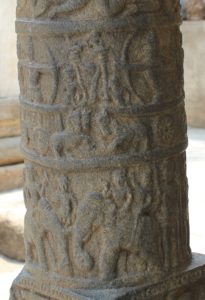
This is a contemporary depiction of the Battle of Takkolam (949 CE) as it is shown on a pillar of a temple built by Butuga II (939-960 CE) of the Western Ganga dynasty (a Rashtrakuta empire vassal) as a fitting finale to his victory over the Cholas of Tanjore at the Takkolam battle. The reliefs on the circular pillars of the Nandi Mandapa depict the defeat of Chola commander Rajaditya by Butuga Il who fought for the Rashtrakutas. Location: Arakeshwara temple (also spelt Arakeshvara or Arakesvara) in Hole Alur, Chamarajanagar district, Karnataka state, India.
Ever since Crown Prince Rajaditya was anointed as the commander of the northern Chola outpost at thirumunaipAdi nAdu, things began boiling on those frontiers. The Rashtrakuta King Krishna III ( referred to as Kannaradeva in inscriptions) , an adversary of the Cholas , during those times, decided to take on the Cholas led by the valiant Crown Prince Rajaditya and the battle was fought in Takkolam, a town today in North Arcot/Vellore District in Tamilnadu in the year 949 AD. According to Prof Nilakanta Sastri, the Rashtrakutas allied with the Banas and Vaidumbas along with the Western Ganga clan of Kings and went into the battle against the Cholas. Crown Prince Rajaditya died in this battle leading the Chola forces.
According to historical records, Butuga II of the Western Ganga clan who was fighting the Cholas alongside the Rashtrakutas, killed Prince Rajaditya, seated on an elephant, by deceit. Chola records of the period bemoan the death of the young & valiant Chola Prince & heir apparent eulogizing him as ‘AnaimEl tunjiya tEvar’ (the Prince who gave up his life, atop an elephant). The Leyden Copper Plates tracing the Chola history recounts the event in its narrative as under:
“ The heroic Rajaditya, the ornament of the Solar race, having shaken in battle the unshakeable Krishna Raja with his forces by means of his sharp arrows flying in all directions, was himself pierced in his heart while seated on the back of a large elephant, by the sharp arrows of the enemy and thus won the praise of the three worlds even as he ascended to the heaven of heroes in a tall vimana.”
While it definitely plunged the Royal House and the entire Chola Kingdom into grief, for Vellan Kumaran the Prince’s unfortunate and sudden demise would have been emotionally catastrophic, for he was the Prince’s vayasya – a constant companion and friend. It is known that for some unknown reason, Vellan Kumaran had not been by the side of the Crown Prince that fateful afternoon at the battlefield at Takkolam and most probably it added a further element emotional & mental trauma of not being there to defend his bosom friend and master.
Left to survive alone, without his much beloved Crown Prince, master and a bosom friend, this great warrior Vellan Kumaran went through pangs of guilt. The trauma that he underwent is captured by the following Sanskrit inscription which also captures the atonement that this great warrior resorted to, so as to assuage and rid himself of his feelings of guilt.
bālye vidyāsamastās svayam adhigatavān bāhuśālī viśālībhūtoras sthāpitaśrīr bhuvanahitarataś coladeśaṃ sametya |
rājādityasya rājñaḥ prakaṭataragurusnehasamāntabhāvaṃ yaḥ prāpto’sannidhānāt sahamaraṇasukhaṃ saṃyuge tena nāptataḥ ||
Epigraphia Indica 27 (1947–48), no. 47: v. 2. Page 292-
Translation:
That strong armed one, having acquired as a child all the sciences of the world, and with Śrī fixed on his broad chest, and devoted to the welfare of the world ( i.e Vellan Kumaran) , entered the lands of the Chola, and achieved the position of a vassal of king Rājāditya on account of his great and very transparent affection, but did not obtain, owing to his absence, the happiness of dying with him together on the battlefield.
While we have no access to the feelings of Rājāditya and can only guess that Veḷḷaṉ Kumāraṉ’s remembrance and words such as Sneha points to a very close intimacy that is now sadly lost to us. This is however attested by scholars who have studied this part of history.
Vellan Kumaran becomes Caturanana, the mahavratin :
Left to fend for himself emotionally and inwardly consumed by his pangs of guilt, history tells us this warrior left for Kashi seeking to cleanse his so-called sin that he himself deemed to have incurred (albeit for no fault of his). Dr V Raghavan in his commentary on the aforesaid inscription in Epigraphia Indica, mentions that Vellan Kumaran came to be inspired by one Niranjana Guru of Tiruvottriyur (Adigrama or Adipuri as it was known in ancient times) and whereupon sometime between 952 AD- 957AD, he perhaps first lived as a recluse in a cave at Tiruvottriyur which was perhaps the same cave which was inhabited decades prior by the said Niranjana Guru (Niranjana -guha). He then took upon the vow to cleanse his conscience, became a mahavratin and thereafter came to be known as Caturanana Pandita. Dr V Raghavan makes very interesting observations and deductions as to this transformation of Vellan Kumaran, a warrior into a monk Caturanana who then established a monastery (matha) at Tiruvottriyur.
In sum, Caturanana Pandita I was Vellan Kumaran is his pUrvAsrama and a warrior, between 930 AD – 945 or 949 AD (the year of the battle of Takkolam) and as the monk and as a Pontiff with the name of Caturanana Pandita between 949 or 950 till 959 AD where upon all records about his existence as available to us, fall silent. It is known that he was succeeded by a lineage of Pontiffs who all took the same titular appellation of Caturanana Pandita all the way till 1173 AD again where after, no mention of any Caturanana Panditas or of the matha at Tiruvottriyur survives for our benefit. According to Dr Raghavan there is no trace of this matha or its remnants anywhere in Tiruvottriyur today. It has to be mentioned that it was at the instance of one of the subsequent Caturanana Panditas that the vimAnam / temple tower for Lord Adhipurisvara of the Tiruvottriyur temple was built by the Chola Kings later in the 11th century.
In the context of Vellan Kumaran’s absence from Prince Rajaditya’s side in the Takkolam Battle theories abound and the take of historians on the same is given in Foot note 3.
MUSICAL HOMAGE TO THE GREAT SOUL
As attested to by Dr V Raghavan nothing survives to us from that age of roughly 1000 odd years back from today. Neither is there any trace of the matha/monastery at Tiruvottriyur or that of any immediate vestiges or artifacts attesting to the existence of the first Caturanana Pandita nee Vallabhan or Vellan Kumaran, save for the inscriptions that have come to us from those times. The temple complex at Tiruvottriyur being the shrine of Lord Adhipurisvara and the shrine of Lord Dakshinamurti or Gaulisa, the presiding deity of the kALAmukhas, therein are the only mute witnesses who can testify to this historical character and his existence. As we know Tiruvottriyur is one of the seven viTanka ksetras, being an abode of Lord Tyagaraja, the sOmAskanda form of Lord Shiva. And as a musical homage to that great soul Caturanana Pandita I, presented here is a composition on Lord Tyagaraja at Tiruvottriyur by Tiruvottriyur Tyagier, son of the great composer Veena Kuppayyar.
Both Dr V Raghavan and Dr Daud Ali in their works espouse a much higher and different level of friendship / affinity / closeness / intimacy that Vellan Kumaran and Prince Rajaditya shared. It is inferable that the protagonists must have shared this affinity mutually. For us today the closest emotion or bhava one can get to, in terms of the yearning they must have shared for each other can at best only be equated to the emotion of Virahotkantitha Nayika (विरहोत्कंठित नायिका – One distressed by separation), a highly aesthetic emotion being one amongst the so-called bouquet of eight, in the world of dance & music. And it certainly would have been an equivalent emotion, one of separation that Vellan Kumaran would have suffered post 949 AD along with his feelings of guilt and remorse.
In line with this bhAva, I seek to present a composition which in fact depicts a love lorn nAyikA, dispatching her friend with a message to her nAyakA, Lord Tyagaraja at Tiruvottriyur, asking him not to tarry and be in communion with her. And one can certainly place the song in perspective, as Vellan Kumaran in his metamorphosis as the mahAvratin Caturanana Pandita would have transformed that yearning or emotion, by directing that to Lord Tyagaraja, the Lord of Tiruvottriyur, the very place where he spent the rest of his life.
This composition ‘sAmi nI rammanavE sArasAkshirO’ is a sprightly pada varna in the raga Kedaram, set in rupaka tala rendered by Sangita Kalanidhi Sanjay Subramanian. The varna as one can notice has sahitya for its cittasvara and ettugada svara sections which are rendered fully by the Vidvan.
CONCLUSION:
History is littered with many such undiscovered personalities and great men who made a lasting contribution during their lifetime. In the instant case from amongst several warriors Vellan Kumaran, a person who wasn’t a member of the Chola Royal House, is singled out in the Chola inscriptions of those times. And it must have been doubtless for some great contribution and importance, to the Kingdom. Again, given that he was a man of letters as well, it’s a tragedy that we know next to nothing about his contribution in his second life as Caturanana Pandita, except that the matha / monastery that he founded survived for more than 200 years after his demise and with his successors commanding the greatest of respect from successive Chola Kings, which is no mean feat. And so, His Holiness Caturanana Pandita I, a preceptor and founder of the great and now lost kALAmukha matha at Tiruvottriyur must have truly been a great man of those times. May glory be to him!
References:
- David N Lorenzen (1972) – “The Kapalikas and Kalamukhas”- Published by Thomson Press (India) Ltd – pp 73-140
- Dr V Raghavan (1947-1948) – Item No 47: “Tiruvorriyur Inscription of Caturanana Pandita”- Epigraphia Indica Vol XXVII- Printed & Published by the Govt of India; pp 292-303
- K V Subramanya Aiyar (1923)- ‘Travancore Archaeological Series Vol III – page 202
- K A Nilakanta Sastri (1955) – The Colas (English)– University of Madras- pp 128-139
- Dr Daud Ali (2017)- “The Death of a Friend: Companionship, Loyalty and Affiliation in Chola South India” – Studies in History Volume: 33 issue: 1, page(s):36-60 – Published by Jawaharlal Nehru University & Sage Publications
- Rajeswari Ghose (1996)- “The Lord of Arur, The Tyagaraja Cult in Tamil Nadu-A Study in conflict and Accommodation” published by Motilal Banarsidass – pp 148-181
- S R Balasubramanian (1971) – “Early Chola Temples”- published by Orient Longman Ltd – pp 299-309
- S R Balasubramanian (1975) – “Middle Chola Temples”- published by Thomson Press India Ltd – pp 299-309
FOOT NOTE 1:
The Gaulisa icon, being a variant of Lord Dakshinamurti, worshipped by kALAmukhAs, as enshrined in the temple complex at Tiruvottriyur has a yogic posture, four-armed, lower right arm in cin-mudra pose, the lower left hand is held parallel to the ground and close to the torso with the palm open upwards, the upper right hand holds a trident and the upper left hand holds a bowl. This unique icon has bewildered iconographers and historians as it is an odd and a not encountered elsewhere, form of Lord Shiva. The article tilted “Kalamukhas and an Interesting Dakshinamurti Image” – available in the URL below is an excellent commentary on this icon by Dr R Nagaswamy which can be read profitably – http://tamilartsacademy.com/articles/article04.xml
FOOT NOTE 2:
Archaeologist & Epigraphist S R Balasubramaniyan in his work opines that Tirumundeesvaram or Tirumudiyur or Mouligramam or Gramam (as it is called today) was perhaps the place which was the garrison town of the Cholas which was commanded by Prince Rajaditya. He even ventures to state that the name Tirumudiyur came to be assigned to this place as perhaps the anointment of Prince Rajaditya as the Crown Prince and heir apparent took place here and its from here that Prince Rajaditya perhaps held Court as the region’s Viceroy. The inscription records a number of grants made by Vellan Kumaran to this temple of Lord Sivalokanathasvami, situated on the south banks of the Pennai river, near Tirukkoyilur.
http://know-your-heritage.blogspot.com/search/label/Sivalokanathar%20Temple
In so far as the nativity of Vellan Kumaran is concerned , on a similar vein the Travancore Archaeological Series records that the village of Puttur situated in the banks of the Nandi River (as described in the Chola inscription) in Kerala, refers to the village of the same name located near Tirparappu, in Kanyakumari District, the river now being known as Nandiaaru.
http://tourmet.com/thirunandhikarai-cave-temple/
FOOT NOTE 3:
Historians like Prof Fleet, based on Rashtrakuta inscriptions have hypothesized that Vellan Kumaran was a spy of the Rashtrakuta King Krishna and had a hand in the treacherous killing of Prince Rajaditya and which is why he wasn’t fighting beside him in the Battle of Takkolam. Both Prof Nilakanta Sastri and Dr V Raghavan with authority and proper reading of the Chola and Rashtrakuta inscriptions, cogently, authoritatively and conclusively negate Prof Fleet’s hypothesis as untrue. Dr V Raghavan goes on to say that such a conclusion is a baseless conjecture. Nevertheless, he also points out there is no inscription referring to Vellan Kumaran during the period of 943 AD and 957 AD & given that the Battle of Takkolam being dateable to the year 949 AD, the question that begs for an answer is where was this Commander Vellan Kumaran between AD 943-949? Though historians like Prof Fleet probably looked at that as an evidence of Vellan Kumaran being a spy of the Rashtrakutas and having weaned him away, Krishna III found it easier to eliminate Prince Rajaditya, one is left grappling with a very tricky question. One wonders whether Prince Rajaditya directed Vellan Kumaran to be with his father Parantaka I, in case the war with the Rashtrakutas turned against the Cholas and Krishna III landed up outside the Tanjore Fort? And is that why Vellan Kumaran did not fight alongside Prince Rajaditya at Takkolam? This line of argument is a hypothesis and there is no shred of direct or collateral evidence to back this up. Be that as it may, the Tiruvottriyur inscription of 957 AD which captures the grief and the act of atonement of Vallabhan/Vellan Kumaran still leaves this question tantalizingly open for us.
It has to be pointed out that Prince Rajaditya was a also a great benefactor for modern Tamil Nadu as he was the one built the Veeranarayana Eri (Lake) or Veeranam Lake, which supplies water to Chennai and irrigates several acres of land by storing up the floods/surplus Cauvery waters, which would go waste when discharged directly to the sea, via Kollidam, in order to prevent floods in Tanjore delta areas. Legend has it that when Prince Rajaditya had mobilized his army to take on the Rashrakutas, he had to idle his troops till such time the weather/season and time was in his favour. In the interregnum he proceeded to deploy the troops productively by conceptualizing the Veeranarayana Eri (Lake) or Veeranam Lake and had it constructed by them to store the surplus waters and also prevent flooding of downstream Tanjore delta areas! Such was his foresight that till date the lake remains the largest man-made lake in this part of the world and an irrigational infrastructural marvel of the Cholas.
https://www.thehindu.com/features/metroplus/society/a-chola-gift-to-chennai/article7089318.ece

